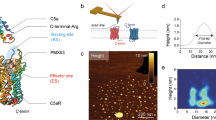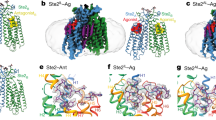Abstract
More than 90% of G protein–coupled receptors (GPCRs) contain a disulfide bridge that tethers the second extracellular loop (EC2) to the third transmembrane helix. To determine the importance of EC2 and its disulfide bridge in receptor activation, we subjected this region of the complement factor 5a receptor (C5aR) to random saturation mutagenesis and screened for functional receptors in yeast. The cysteine forming the disulfide bridge was the only conserved residue in the EC2-mutated receptors. Notably, ∼80% of the functional receptors exhibited potent constitutive activity. These results demonstrate an unexpected role for EC2 as a negative regulator of C5a receptor activation. We propose that in other GPCRs, EC2 might serve a similar role by stabilizing the inactive state of the receptor.
This is a preview of subscription content, access via your institution
Access options
Subscribe to this journal
Receive 12 print issues and online access
$189.00 per year
only $15.75 per issue
Buy this article
- Purchase on Springer Link
- Instant access to full article PDF
Prices may be subject to local taxes which are calculated during checkout





Similar content being viewed by others
References
Pierce, K.L., Premont, R.T. & Lefkowitz, R.J. Signalling: seven-transmembrane receptors. Nat. Rev. Mol. Cell Biol. 3, 639–650 (2002).
Gether, U. Uncovering molecular mechanisms involved in activation of G protein–coupled receptors. Endocr. Rev. 21, 90–113 (2000).
Karnik, S.S., Gogonea, C., Patil, S., Saad, Y. & Takezako, T. Activation of G-protein-coupled receptors: a common molecular mechanism. Trends Endocrinol. Metab. 14, 431–437 (2003).
Palczewski, K. et al. Crystal structure of rhodopsin: a G protein–coupled receptor. Science 289, 739–745 (2000).
Okada, T. et al. Functional role of internal water molecules in rhodopsin revealed by X-ray crystallography. Proc. Natl. Acad. Sci. USA 99, 5982–5987 (2002).
Schertler, G.F. Structure of rhodopsin. Eye 12, 504–510 (1998).
Baldwin, J.M., Schertler, G.F. & Unger, V.M. An α-carbon template for the transmembrane helices in the rhodopsin family of G-protein-coupled receptors. J. Mol. Biol. 272, 144–164 (1997).
Shi, L. & Javitch, J.A. The binding site of aminergic G protein–coupled receptors: the transmembrane segments and second extracellular loop. Annu. Rev. Pharmacol. Toxicol. 42, 437–467 (2002).
Baranski, T.J. et al. C5a receptor activation. Genetic identification of critical residues in four transmembrane helices. J. Biol. Chem. 274, 15757–15765 (1999).
Geva, A., Lassere, T.B., Lichtarge, O., Pollitt, S.K. & Baranski, T.J. Genetic mapping of the human C5a receptor. Identification of transmembrane amino acids critical for receptor function. J. Biol. Chem. 275, 35393–35401 (2000).
Dayhoff, M.O., Schwartz, R.M. & Orcutt, B.C. In Atlas of Protein Sequence and Structure Vol. 5 (ed. Dayhoff, M.O.) 345–353 (National Biomedical Research Foundation, Silver Spring, Maryland, USA, 1978).
Fauchere, J.L., Charton, M., Kier, L.B., Verloop, A. & Pliska, V. Amino acid side chain parameters for correlation studies in biology and pharmacology. Int. J. Pept. Protein Res. 32, 269–278 (1988).
Gerard, C. & Gerard, N.P. C5A anaphylatoxin and its seven transmembrane-segment receptor. Annu. Rev. Immunol. 12, 775–808 (1994).
Cain, S.A., Higginbottom, A. & Monk, P.N. Characterisation of C5a receptor agonists from phage display libraries. Biochem. Pharmacol. 66, 1833–1840 (2003).
Kolakowski, L.F., Jr., Lu, B., Gerard, C. & Gerard, N.P. Probing the “message:address” sites for chemoattractant binding to the C5a receptor. Mutagenesis of hydrophilic and proline residues within the transmembrane segments. J. Biol. Chem. 270, 18077–18082 (1995).
Karnik, S.S., Sakmar, T.P., Chen, H.B. & Khorana, H.G. Cysteine residues 110 and 187 are essential for the formation of correct structure in bovine rhodopsin. Proc. Natl. Acad. Sci. USA 85, 8459–8463 (1988).
Davidson, F.F., Loewen, P.C. & Khorana, H.G. Structure and function in rhodopsin: replacement by alanine of cysteine residues 110 and 187, components of a conserved disulfide bond in rhodopsin, affects the light-activated metarhodopsin II state. Proc. Natl. Acad. Sci. USA 91, 4029–4033 (1994).
Zeng, F.Y., Soldner, A., Schoneberg, T. & Wess, J. Conserved extracellular cysteine pair in the M3 muscarinic acetylcholine receptor is essential for proper receptor cell surface localization but not for G protein coupling. J. Neurochem. 72, 2404–2414 (1999).
Reddy, P.S. & Corley, R.B. Assembly, sorting, and exit of oligomeric proteins from the endoplasmic reticulum. Bioessays 20, 546–554 (1998).
Floyd, D.H. et al. C5a receptor oligomerization II: fluorescence resonance energy transfer studies of a human G protein–coupled receptor expressed in yeast. J. Biol. Chem. 278, 35354–35361 (2003).
Whistler, J.L. et al. Constitutive activation and endocytosis of the complement factor 5a receptor: evidence for multiple activated conformations of a G protein–coupled receptor. Traffic 3, 866–877 (2002).
Cook, J.V. & Eidne, K.A. An intramolecular disulfide bond between conserved extracellular cysteines in the gonadotropin-releasing hormone receptor is essential for binding and activation. Endocrinology 138, 2800–2806 (1997).
Shi, L. & Javitch, J.A. The second extracellular loop of the dopamine D2 receptor lines the binding-site crevice. Proc. Natl. Acad. Sci. USA 101, 440–445 (2004).
Parnot, C., Miserey-Lenkei, S., Bardin, S., Corvol, P. & Clauser, E. Lessons from constitutively active mutants of G protein–coupled receptors. Trends Endocrinol. Metab. 13, 336–343 (2002).
Milligan, G. Constitutive activity and inverse agonists of G protein–coupled receptors: a current perspective. Mol. Pharmacol. 64, 1271–1276 (2003).
abu Alla, S. et al. Extracellular domains of the bradykinin B2 receptor involved in ligand binding and agonist sensing defined by anti-peptide antibodies. J. Biol. Chem. 271, 1748–1755 (1996).
Ott, T.R. et al. Two mutations in extracellular loop 2 of the human GnRH receptor convert an antagonist to an agonist. Mol. Endocrinol. 16, 1079–1088 (2002).
Mobini, R. et al. Probing the immunological properties of the extracellular domains of the human β(1)-adrenoceptor. J. Autoimmun. 13, 179–186 (1999).
Lebesgue, D. et al. An agonist-like monoclonal antibody against the human β2- adrenoceptor. Eur. J. Pharmacol. 348, 123–133 (1998).
Wang, W. et al. Stimulatory activity of anti-peptide antibodies against the second extracellular loop of human M2 muscarinic receptors. Chin. Med. J. (Engl.) 113, 867–871 (2000).
Filipek, S. et al. A concept for G protein activation by G protein–coupled receptor dimers: the transducin/rhodopsin interface. Photochem. Photobiol. Sci. 3, 628–638 (2004).
Pease, J.E., Burton, D.R. & Barker, M.D. Generation of chimeric C5a/formyl peptide receptors: towards the identification of the human C5a receptor binding site. Eur. J. Immunol. 24, 211–215 (1994).
Crass, T. et al. Chimeric receptors of the human C3a receptor and C5a receptor (CD88). J. Biol. Chem. 274, 8367–8370 (1999).
DeMartino, J.A. et al. The amino terminus of the human C5a receptor is required for high affinity C5a binding and for receptor activation by C5a but not C5a analogs. J. Biol. Chem. 269, 14446–14450 (1994).
Siciliano, S.J. et al. Two-site binding of C5a by its receptor: an alternative binding paradigm for G protein–coupled receptors. Proc. Natl. Acad. Sci. USA 91, 1214–1218 (1994).
Gerber, B.O., Meng, E.C., Dotsch, V., Baranski, T.J. & Bourne, H.R. An activation switch in the ligand binding pocket of the C5a receptor. J. Biol. Chem. 276, 3394–3400 (2001).
Polak, M. Hyperfunctioning thyroid adenoma and activating mutations in the TSH receptor gene. Arch. Med. Res. 30, 510–513 (1999).
Shenker, A. Activating mutations of the lutropin choriogonadotropin receptor in precocious puberty. Receptors Channels 8, 3–18 (2002).
Parma, J. et al. Somatic mutations causing constitutive activity of the thyrotropin receptor are the major cause of hyperfunctioning thyroid adenomas: identification of additional mutations activating both the cyclic adenosine 3′,5′-monophosphate and inositol phosphate-Ca2+ cascades. Mol. Endocrinol. 9, 725–733 (1995).
Li, S., Liu, X., Min, L. & Ascoli, M. Mutations of the second extracellular loop of the human lutropin receptor emphasize the importance of receptor activation and de-emphasize the importance of receptor phosphorylation in agonist-induced internalization. J. Biol. Chem. 276, 7968–7973 (2001).
Ryu, K. et al. Modulation of high affinity hormone binding. Human choriogonadotropin binding to the exodomain of the receptor is influenced by exoloop 2 of the receptor. J. Biol. Chem. 273, 6285–6291 (1998).
Decaillot, F.M. et al. Opioid receptor random mutagenesis reveals a mechanism for G protein–coupled receptor activation. Nat. Struct. Biol. 10, 629–636 (2003).
Parnot, C. et al. Systematic identification of mutations that constitutively activate the angiotensin II type 1A receptor by screening a randomly mutated cDNA library with an original pharmacological bioassay. Proc. Natl. Acad. Sci. USA 97, 7615–7620 (2000).
Holst, B. & Schwartz, T.W. Molecular mechanism of agonism and inverse agonism in the melanocortin receptors: Zn(2+) as a structural and functional probe. Ann. NY Acad. Sci. 994, 1–11 (2003).
Nanevicz, T., Wang, L., Chen, M., Ishii, M. & Coughlin, S.R. Thrombin receptor activating mutations. Alteration of an extracellular agonist recognition domain causes constitutive signaling. J. Biol. Chem. 271, 702–706 (1996).
Altenbach, C., Klein-Seetharaman, J., Cai, K., Khorana, H.G. & Hubbell, W.L. Structure and function in rhodopsin: mapping light-dependent changes in distance between residue 316 in helix 8 and residues in the sequence 60–75, covering the cytoplasmic end of helices TM1 and TM2 and their connection loop CL1. Biochemistry 40, 15493–15500 (2001).
Brown, A.J. et al. Functional coupling of mammalian receptors to the yeast mating pathway using novel yeast/mammalian G protein α-subunit chimeras. Yeast 16, 11–22 (2000).
Thompson, J.D., Higgins, D.G. & Gibson, T.J. CLUSTAL W: improving the sensitivity of progressive multiple sequence alignment through sequence weighting, position–specific gap penalties and weight matrix choice. Nucleic Acids Res. 22, 4673–4680 (1994).
Acknowledgements
We thank G. Nikiforovich, H. Bourne, K. Blumer, E. Meng and members of the Baranski lab for helpful discussions and review of the manuscript. This work was supported by an award from the American Heart Association (J.M.K.) and by grants from the American Cancer Society IRG-58-010-43 (T.J.B.), the Culpeper Award, Rockefeller Brothers Fund (T.J.B.), and the US National Institutes of Health, GM63720-01 (T.J.B.).
Author information
Authors and Affiliations
Corresponding author
Ethics declarations
Competing interests
The authors declare no competing financial interests.
Supplementary information
Supplementary Fig. 1
Localization of C5aR cysteine mutants in yeast. (PDF 851 kb)
Supplementary Fig. 2
Expression of NQ receptors in yeast. (PDF 367 kb)
Supplementary Fig. 3
Alignment of EC2 residues in C5aR and rhodopsin. (PDF 42 kb)
Rights and permissions
About this article
Cite this article
Klco, J., Wiegand, C., Narzinski, K. et al. Essential role for the second extracellular loop in C5a receptor activation. Nat Struct Mol Biol 12, 320–326 (2005). https://doi.org/10.1038/nsmb913
Received:
Accepted:
Published:
Issue Date:
DOI: https://doi.org/10.1038/nsmb913
This article is cited by
-
Mechanism of activation and biased signaling in complement receptor C5aR1
Cell Research (2023)
-
Molecular dynamics of the histamine H3 membrane receptor reveals different mechanisms of GPCR signal transduction
Scientific Reports (2020)
-
A benchmark study of loop modeling methods applied to G protein-coupled receptors
Journal of Computer-Aided Molecular Design (2019)
-
Chimeric protein probes for C5a receptors through fusion of the anaphylatoxin C5a core region with a small-molecule antagonist
Science China Chemistry (2019)
-
The Model Structures of the Complement Component 5a Receptor (C5aR) Bound to the Native and Engineered hC5a
Scientific Reports (2018)



